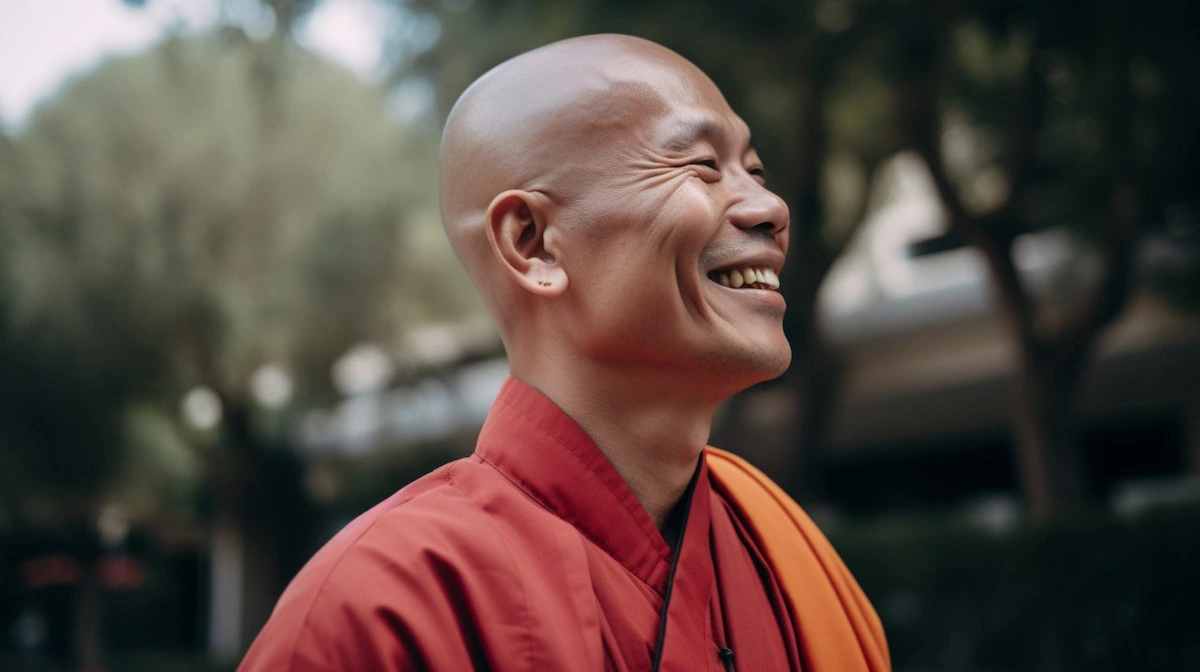As you walk the spiritual path, drawn by the ageless wisdom of the Buddha, imagine finding yourself standing at a vibrant crossroads. This is where the different types of Buddhism intersect, offering you unique paths to enlightenment.
From the self-focused discipline of Theravada to the compassionate outreach of Mahayana and the esoteric rituals of Vajrayana, Buddhism is a spectrum of philosophies and practices you can choose from.
Regardless of the route you pick, each will contribute to your pursuit of peace, self-realization, and ultimate nirvana.
How many types of Buddhism are there?
Originating in the 6th century BCE in Nepal, Buddhism’s teachings transcended time and space, having devoted practitioners in every part of the world. As it encountered new cultures and societies, it naturally adapted to fit the local customs, beliefs, and philosophical systems it encountered.
For instance, the Buddhism that took root in the verdant landscapes of Southeast Asia, largely of the Theravada tradition, developed distinct characteristics. In contrast, the Buddhism that traveled the Silk Road to China and Japan primarily evolved into various schools of Mahayana Buddhism.
Similarly, the unique practices and rituals associated with Vajrayana Buddhism developed under the influence of the indigenous Bon tradition in Tibet.
Each new place it spread to and each new generation of practitioners added their own interpretations and adaptations. This resulted in a multitude of Buddhist schools and traditions, such as Zen, Pure Land, Nichiren, Jodo Shinshu, Vipassana, and Samatha.
So it’s difficult to quantify the exact number of variations of Buddhism due to this rich diversity and fluidity. Each has their own unique methods of how to practice Buddhism and philosophical interpretations, contributing to the vast mosaic that constitutes this religion today.
What are the 3 types of Buddhism?
The three main branches of Buddhism are Theravada, Mahayana, and Vajrayana. Let’s delve deeper into understanding these three types of Buddhism, exploring their origins, core beliefs, and practices.
1. Theravada Buddhism: The School of the Elders
Theravada, or the School of the Elders, is the oldest school of Buddhism and draws its practices from the earliest Buddhist teachings.
Theravada Buddhism follows the Pali Canon, the oldest recorded teachings of the Buddha. The teachings are written in the ancient Indian language, Pali. Both Theravada Buddhism and Hinduism feature the Pali language.
It is the most conservative branch of Buddhism. In fact, a number of strict rules govern Theravada meditation practice. And new teachings are often rejected from the practice.
The aim of Theravada Buddhism is to become an arhat—a fully awakened being. This can be achieved through meditation, the contemplation of sutras, and following the Buddha’s Noble Eightfold Path.
The Noble Eightfold Path includes the right vision, the right emotion, the right speech, the right action, the right livelihood, the right effort, the right mindfulness, and the right meditation.
Today, Theravada Buddhism is most popular in Sri Lanka, Thailand, Laos, Cambodia, and Myanmar.
2. Mahayana Buddhism: The Great Vehicle
Next up is Mahayana Buddhism, the most popular branch of Buddhism today. Mahayana Buddhism is most popular in Nepal, Japan, China, Tibet, and Korea.
In Sanskrit, Mahayana means “Great Vehicle.” This is a reference to the Mahayana Buddhist teaching of the bodhisattva, a person who has become awakened.
In fact, bodhisattvas have the ability to access nirvana, the state beyond suffering. But instead of doing so, they choose to delay their nirvana to guide and teach others.
In Mahayana Buddhism, anyone can become a bodhisattva and work to help others achieve freedom from suffering. Unlike Theravada Buddhism, the Mahayana tradition allows for new teachings outside the Pali canon.
Popular sutras in Mahayana Buddhism are the Lotus Sutra and the Heart Sutra.
Compassion is the sense of heart expansion, connecting with all sentient beings. It’s the sense of something limitless and unconditional, something pure.
— Gelong Thubten, trainer of Mindvalley’s Becoming More Loving program
3. Vajrayana Buddhism: The Way of the Diamond
Vajrayana Buddhism is known as “the Way of the Diamond,” also called Tantric or Esoteric Buddhism. And as far as different types of Buddhism go, Vajrayana is one of the most unique.
What makes Vajrayana Buddhism so special is its approach to rapid enlightenment through the use of tantras—mystical texts that date back to the 6th century BCE. Some of these practices combine spiritual and physical practices that can be overwhelming for beginners.
Because of the intense application needed for many Vajrayana Buddhist practices, most Vajrayana schools only accept advanced teachers and students.
In essence, Vajrayana Buddhists aim to become Buddhas themselves. Its teachings are preserved in the Tibetan Buddhist canon, written in Tibetan.
What do they have in common?
While Theravada, Mahayana, and Vajrayana Buddhism each present unique paths toward enlightenment, they are rooted in the same foundational teachings of the Buddha. Here are several core beliefs and principles they share in common:
- The Four Noble Truths. At the heart of all three forms are the Four Noble Truths, which expound on the nature of suffering, its origin, its cessation, and the path leading to its cessation. Additionally, they all recognize the Eightfold Path as the way to end suffering, encompassing the right view, right intention, right speech, right action, right livelihood, right effort, right mindfulness, and right concentration.
- The principle of karma. The law of cause and effect is another common thread that binds these traditions. Actions, whether good or bad, have consequences that can affect your current life or future rebirths.
- Rebirth. All three types of Buddhism uphold the concept of rebirth or reincarnation, a continuous cycle of birth, death, and rebirth, from which one seeks liberation.
Finally, the ultimate goal in all these traditions is the attainment of enlightenment, or nirvana, a state of liberation from the cycle of rebirth and suffering.

What are the main differences between the 3 types of Buddhism?
Theravada, Mahayana, and Vajrayana Buddhism have their own distinctions. And it all has to do with their differing perspectives on the path to enlightenment and their interpretation and practice of Buddhist teachings.
To better understand these differences, here’s a comparison table:
| Type of Buddhism | Theravada Buddhism | Mahayana Buddhism | Vajrayana Buddhism |
| Goal | To become an Arhat (enlightened saint) | To become a Bodhisattva (compassionate enlightened being) | To become a Buddha (enlightened being) |
| Path to enlightenment | Through self-discipline and meditation | Through altruism and a variety of practices depending on the school | Through specific rituals and techniques, including mantras and meditation |
| Main focus | Individual enlightenment | Compassion and altruism | Rapid enlightenment in a single lifetime |
| Scriptures | Pali Canon (Pali language) | Various scriptures in multiple languages | Tibetan Buddhist Canon (Tibetan language) |
| Geographic concentration | Predominantly in Sri Lanka, Thailand, Laos, Cambodia, and Myanmar | Predominantly in China, Japan, Korea, and Vietnam | Predominantly in Tibet, Mongolia, Bhutan, and parts of Nepal and India |
| Philosophy and teachings | Focuses on the earliest texts and monastic discipline | Greater emphasis on Buddha-nature and compassion | Incorporates tantric practices and esoteric teachings |
| Worship and practices | Focuses on meditation and mindfulness | Various practices depending on the school (e.g., Zen, Pure Land) | Utilizes rituals, mantras, and tantra practices |
The distinctions among them provide rich diversity within the practice of Buddhism. They offer you the freedom to choose the path that resonates most deeply with your individual spiritual journey.
What are the 5 rules of Buddhism?
These five rules, also called the five precepts, are common to most branches of Buddhism:
- “I undertake the precept to abstain from killing breathing beings.”
- “To abstain from taking what is not mine.”
- “I undertake the precept to abstain from misconduct concerning sense-pleasures.”
- “To abstain from false speech.”
- “I undertake the training precept to abstain from alcoholic drinks or drugs that are an opportunity for heedlessness.”
In essence, these five precepts form the ethical foundation of Buddhism. They guide practitioners towards living a life of compassion and mindfulness, free from harm to self and others, and contributing to their path toward enlightenment.
Integrating spirituality into your life
In the ceaseless hustle of the modern world, it’s a never-ending challenge to detach from external noise and constant distractions. The overflow of information, fast-paced life, and increasing expectations often contribute to stress and anxiety and hinder us from connecting with our inner selves and the profound tranquility within.
This is why spirituality can be the path to inner peace and fulfillment.
But much like any religion, it can become an unapplied philosophy if not practiced daily. Its principles and teachings are meant to be lived, not just contemplated.
If you want to learn how to integrate spirituality into every aspect of life, Mindvalley can help. Here, you can learn how to:
- Meditate like a monk with Gelong Thubten’s Becoming More Loving program,
- Become vibrantly alive with Sadhguru’s A Yogi’s Guide to Joy program, and
- Unlock your spiritual potential with Jeffrey Allen’s Unlocking Transcendence program.
And by unlocking your free access, you have the opportunity to try out sample classes from all the programs above and many others.
Welcome in.








